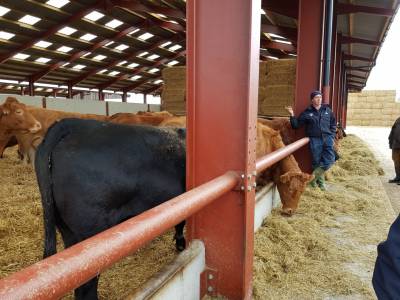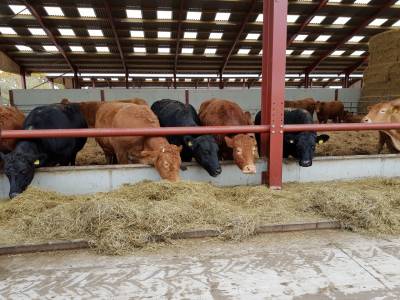

British Cattle Breeders Club – November's Farm Visit to Yorkshire
The British Cattle Breeders Club recently visited Oak House Farm at Green Hammerton near York, the newly built farmstead of the Powley family’s beef herd and arable enterprise. The farmstead comprises of 130ha, with 50ha owned and 80ha rented from 5 different landlords. The arable enterprise covers 60ha with the remaining 70ha a selection of long-term leys, permanent pasture and higher-level stewardship that support the 90 head suckler herd.
Mike Powley has taken knowledge from Gabe Brown, a US cattle and sheep farmer, who is regenerating landscapes for a sustainable future and believes that improving soil health is a priority and practices no-tillage. At Oak House farm conservation tillage/no-till is used to establish crops and as a result, Mike has seen improved soil health with crops yielding approximately 10-15% more. The arable enterprise grows winter wheat, winter and spring barley, spring beans and red clover for silage in the rotation and 20ha of cover crops are grown each year.
Previous to the new farmstead the farm was split over three sites, the new buildings have enabled Mike and his father, Tom, to house the herd on the same site. The buildings are animal focused, light airy and machine friendly enabling general animal husbandry to be performed with ease. The dedicated isolation/handling building has multiple adaptable pens which are also used during calving. The handling area comprises of a round tub with a curved race leading to the manual crush with electronic weigh bars and EID linked to a Gallagher weigh head.
The aim is to increase the suckler herd to around 120-130 cows. They are currently based around South Devon x Limousin home bred cows, with Norwegian Reds being trialled in place of the Limousin. Mike explained that the Norwegian Reds could bring greater fertility and managements traits such as feet, udders, smaller cow and mastitis resistance into the herd. The heifers are calved at two years old, with the first Norwegian Reds calved this Spring, to easy calving Angus, heifers are then subsequently served to British Blue and some to Charolais. AI is used throughout, there is no stock bull on farm and EBV’s are used when choosing sires. The Genus Breeder tag system is used to track cows for service, and an AI technician is used. The conception rate is 74% with the Norwegian Reds at 86%, and a calving interval of 364 days. The herd is spring calving, over a nine-week period and the calves are weighed at birth. The calves are weaned at housing at the end of October/early November. The cows are rotational grazed throughout the summer on two-day paddocks.
At housing all cattle are weighed. The cows are restrict fed silage and straw, with a reducing body condition score for easier calving, resulting in just 4 or 5 assisted calving’s a year. Throughout the winter the calves are weighed every three weeks and growth rates are monitored and recorded. The bulls are fed red clover silage and a home-produced barley/bean mix, with molasses and minerals being the only bought in feeds, and are fast finished over the winter and sold at 13-14 months old at 400-420kg compared to around 500kg previously. The heifers are fed the best quality red clover silage and some barley/maize gluten over winter. Then turned out to graze and are finished off grass or rehoused in the autumn and “fast finished” on the same diet as the bulls. All are sold by 20-21 months old.
The Powley’s have recently started a Box Beef scheme, selling beef locally in 10kg boxes, which is proving popular. An informative visit to a family farmstead who have made changes to their breeding programme and utilised the information and technology available to them to produce a sustainable end product. Mike Powley will be speaking at our conference in January, where he will speak further on his breeding programme and the direction of the suckler herd, and how he is preparing the farm’s soils for the future using carbon to make them a stable and sustainable asset for the next generation.